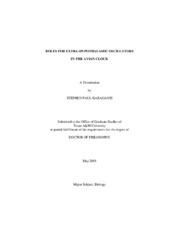| dc.description.abstract | Avian circadian clocks are composed of a distributed network of neural and
peripheral oscillators. Three neural pacemakers, located in the pineal, the eyes, and the
hypothalamus, control circadian rhythms of many biological processes through complex
interactions with slave oscillators located throughout the body. This system, an
astonishing reflection of the life history of this diverse class of vertebrates, allows birds
to coordinate biochemical and physiological processes and harmonize them with a
dynamic environment. Much work has been done to understand what roles these
pacemakers have in avian biology, how they function, and how they interact to generate
overt circadian rhythms. The experimental work presented in this dissertation uses the
domestic chicken, Gallus domesticus, as a model to address these questions and carry
forward current understanding about circadian biology in this species. To do so, we
utilized a custom DNA microarray to investigate rhythmic transcription in cultured chick
pineal cells. We then sought to identify genes which might be a component of the pineal
clock by screening for rhythmic transcripts that are sensitive to a phase-shifting light
stimulus. Finally, we surgically removed the eyes or pineal from chickens to examine the roles of these extra-SCN pacemakers in regulating central and peripheral rhythms in
metabolism and clock gene expression.
Using these methods, we show that the oscillating transcriptome is diminished in
the chick pineal ex vivo, while the functional clustering of clock controlled genes is
similar. This distribution reveals multiple conserved circadian regulated pathways, and
supports an endogenous role for the pineal as an immune organ. Moreover, the
robustness of rhythmic melatonin biosysnthesis is maintained in vitro, demonstrating
that a functional circadian clock is preserved in the reduced subset of the rhythmic pineal
transcriptome. In addition, our genomic screen has yielded a list of 28 genes that are
candidates for functional screening. These should be evaluated to determine any
potential role they may have as a component of the pineal circadian clock. Finally, we
report that the eyes and pineal similarly function to reinforce rhythms in brain and
peripheral tissue, but that metabolism and clock gene expression are differentially
regulated in chick. | en |


